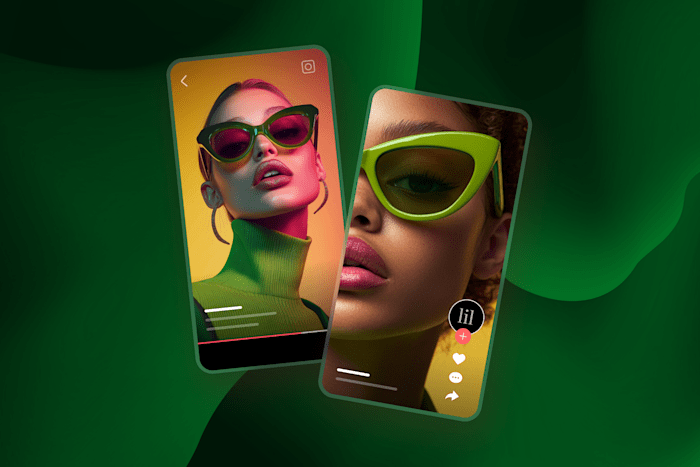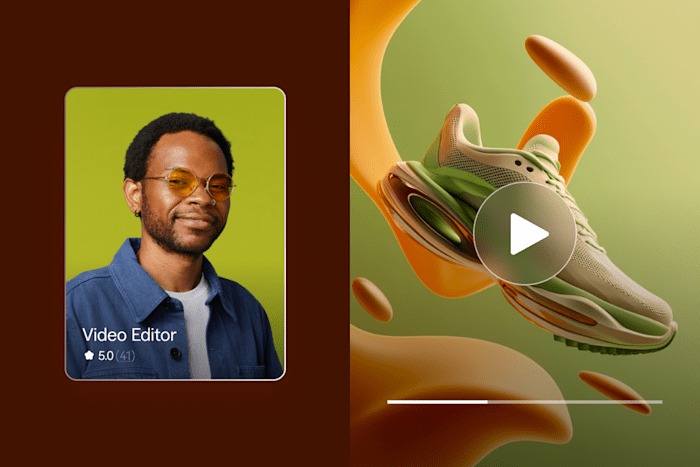How to build a social media video marketing strategy (+ trends, examples, & tools)
You need scriptwriters, video editors, and quality equipment to build an effective social media video strategy. Learn what is working for the top brands and how you can join their ranks.
 February 18, 2025
February 18, 2025 12 minute reading
12 minute reading
Video marketing is one of the most compelling ways to capture attention, drive engagement, and boost sales in the digital world. Its unique ability to blend storytelling with visual appeal makes it an outstanding tool for connecting with audiences on a deeper level.
But what exactly makes video marketing so effective? Is it the way it humanizes brands, the growing accessibility of video creation, or the rise of platforms that prioritize video content?
Before diving into the latest trends and actionable strategies, let’s start by clarifying what video marketing really is and why it matters.
What is social media video marketing?
Social media video marketing uses videos on social media platforms to promote products, services, or brands. It involves creating and sharing engaging video content to capture the target audience's attention, increase brand awareness, and drive user engagement and conversions.
Benefits of using social media video marketing?
The recent surge in video marketing spending reflects the benefits brands see from investing in videos. Digital video advertising rose to $52.1 billion in 2023, according to a report by the Interactive Advertising Bureau (IAB) trade group. Why is video so appealing to advertisers? Here are nine of the top reasons:
1. Video reaches wider audiences
One of the biggest benefits of video is that it helps you reach wider audiences. Streaming video audiences now exceed the size of cable TV audiences, according to recent data from Nielsen.
Following four months of record growth, the size of streaming audiences surpassed cable for the first time in July 2022, with viewers consuming an average of 190.9 billion minutes of streamed content per week. This represented 34.8% of total television consumption, ahead of cable at 34.4% and broadcast at 21.6%. Prime Video, Netflix, Hulu, and YouTube all captured record shares in July.
These are large audiences, and they represent only a portion of the market for videos. Through social video marketing, brands can reach audiences comparable to the size of traditional TV audiences.
2. Video attracts mobile users
One reason video commands such large audiences is that it attracts mobile users. By the end of 2023, video was estimated to account for 73% of all mobile traffic, according to a report by Ericsson.
By 2029, this number is projected to grow to 76%. This makes video the primary driver of mobile device usage. Smartphone users are watching video in many forms, including movies, TV, sports broadcasts, and short video formats such as videos on TikTok, Instagram, and YouTube.
3. Video reaches connected TV (CTV) audiences
Another growing audience that is accessible through video marketing is connected TV viewers. CTV ad spending in the United States is expected to reach $30.1 billion in 2025. This represents a significant increase from the $21.2 billion projected for 2022.
Advertisers like connected TV because it allows them access to types of data not available through traditional TV and delivers better sales results. Additionally, it increases transparency about ad placements and reduces reliance on third-party cookies.
4. Video encourages audience engagement
Higher engagement is another big benefit of video marketing. For example, video ads drive higher engagement on Facebook than other types of content, according to 67% of marketers surveyed by Databox.
Find Video Ads & Commercials Experts for Hire
Video includes a couple of features that encourage audience engagement. For one, videos often require viewers to click to see them, which promotes audience participation.
Beyond this, videos can engage audiences through content that holds viewers’ attention. A video that makes viewers laugh, tells an interesting story, or shares a surprising fact encourages audience engagement.
5. Video promotes social sharing
The engaging nature of video makes viewers want to share videos with their friends and followers on social media. Over 50% of people are more likely to share videos with their friends than any other type of content, according to Wyzowl’s State of Video Marketing 2023 report.
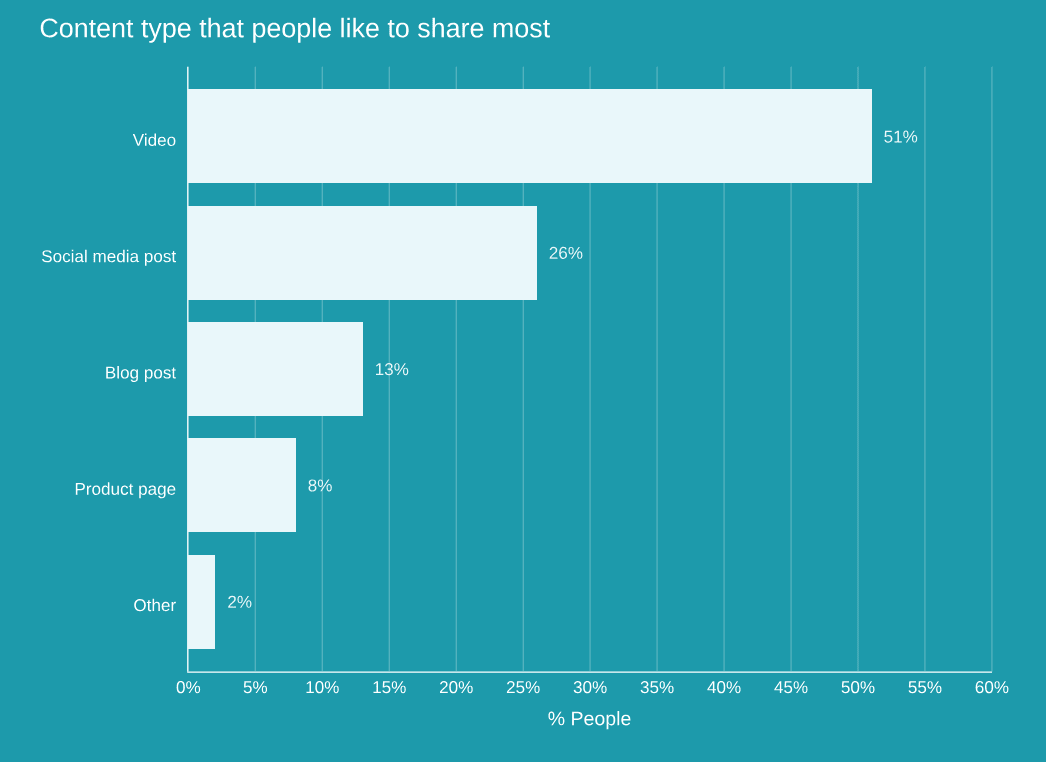
Wizowl
6. Video can help with SEO performance
Video marketing can significantly improve your SEO performance. Adding video to existing content can increase search engine results. Video includes a number of features that can improve your brand’s search engine optimization performance.
You can include keywords in videos just as in other types of content. This allows Google and the internal search engines of platforms like YouTube to index your videos by keyword. On Google, video results appear in a dedicated tab, which can help you compete with text-based content.
Video results often appear with thumbnails. An eye-catching thumbnail increases the odds of a video attracting clicks, increasing your search rankings. Videos may gain additional SEO traction from referrals, shares, and comments. Around 91% of marketers use video as part of their SEO marketing strategy.
7. Video personalizes your brand
Videos help marketers communicate with customers more personally by putting a face on your brand. Other forms of content may lack a personal touch, but video lets customers see who’s talking to them.
This can make customers feel a more personal connection to your company. If the people in your videos are humorous or entertaining, it can also promote engagement and brand loyalty. It’s more important for brands to be authentic in their marketing videos rather than polished, according to 63% of consumers in Hubspot’s US Consumer Trends report.
8. Video dramatizes your products and services
Seeing is believing, and one of the unique advantages of video is that it lets customers see your products and services in action. You can use video to document case studies or depict simulations that show off what you sell.
For example, a video can show what common problems lead customers to turn to your brand. A company selling a kitchen product might begin a video by showing a consumer frustrated over how hard it is to prepare a meal using conventional equipment, setting the stage for offering the product as an innovative solution.
Videos likewise showcase product features and benefits and preempt common sales objections. A video can effectively deliver an entire sales presentation in a dramatic package.
9. Videos provide social proof
Another way video helps marketers is by providing a powerful form of social proof. In contrast to testimonial formats, which rely on text alone, videos allow viewers to see and hear your actual customers describing their experience with your product or service.
Endorsements from celebrities, thought leaders, and other famous personalities carry more impact when delivered on video. Video brings social proof of your products and services to life in a format that is easy to share online.
Find a Video Marketing Expert for Hire
Popular formats of social video marketing media
There are around five billion social media users worldwide and 15 main social media platforms. Depending on the platform, you must make different videos to capture their attention.
Long-form videos
Long-form videos deliver in-depth content, exploring topics thoroughly in over 10 minutes. They excel at tackling complex subjects, storytelling, and detailed tutorials.
By creating long-form videos, content makers build authority and forge stronger audience connections. Repurposing key segments into short clips extends reach, driving interest back to the full content.
Short-form videos (TikTok, YouTube Shorts, and Instagram Reels)
Attention spans are limited on certain platforms, such as TikTok, YouTube, and Instagram. Social media marketing campaigns on these platforms should involve short, fun, concise videos.
Pro tip: Experiment with user-generated content (UGC) videos or try YouTube Shorts.
Livestream videos
Most platforms have livestream capabilities. This can be a great avenue if you’re announcing an exciting event or product launch and want to generate buzz.
Pro tip: Advertise your livestream in advance so your audience can tune in.
Webinars
Webinars are online events that you can broadcast live or pre-record. They are usually delivered via software apps that support one or more presenters and up to thousands of participants.
Pro tip: Send an email with your webinar recording a call-to-action to sign up for the next one.
Animated videos
With the growth of AI, many marketers are turning toward animated videos as part of their video strategy. You can create quality videos in an enticing new format to capture the attention of your target audience.
Pro tip: Use one of these six best AI video generators.
Popular video formats
Take a popular video format or idea and make it your own. Here are some popular ideas to get you started with your social video marketing efforts.
Product videos
Film a tutorial or product demonstration. This will help build trust in your audience and position you as an authority in the space.
For example, A software company creates a 3-minute tutorial video demonstrating how to use their new project management tool. The video discusses key features like creating tasks, assigning team members, and generating reports.
Pro tip: Create product videos and demos to correspond with the launch of a new product or feature.
Find an E-commerce Product Video Expert for Hire
Customer case studies
Customer testimonials or case studies are a great way to (humbly) show off. Show potential customers why people choose you over the competition.
Say an electric car manufacturer produces a 5-minute video featuring a satisfied customer who switched from a gas-powered vehicle. The customer shares their experience, highlighting improved fuel costs, environmental impact, and overall satisfaction with the car's performance.
Pro tip: Feature your customers’ voices in your testimonial videos.
Interviews
Interviews with your employees or other industry experts are a great way to appeal to new audiences. They’re also often easier to produce and allow you to network with other thought leaders.
For example, a good video ad agency starts a monthly video show. In each entertaining video episode, they could interview a different industry expert about topics like ad trends, social media strategies, or content marketing best practices.
Pro tip: Host interviews regularly in the form of an online video podcast.
Entertaining videos
Pay attention to viral trends or memes, and don’t be afraid to incorporate humor into your video ad campaigns—it makes you more personable and relatable. Ninety-one percent of customers want their brands to be funny.
A good video ad agency, for example, created a funny video ad for an air filter brand. The video is shot from the animals' perspectives—instead of their humans’. It shows the animals reacting to their new environment with new clean air filters. The shift in perspective is more interesting, entertaining, and funnier than a salesperson just talking about air filters.
Pro tip: Try out humorous videos on video platforms like TikTok, Facebook, or Instagram first.
Celebration videos
Not every piece of content needs to address customer pain points, sell products, or generate leads. Let customers connect with your brand through video creation around company milestones, anniversaries, or holidays.
For instance, a local bakery celebrates its 10th anniversary by creating a heartwarming video featuring longtime employees sharing their favorite memories, customers talking about their go-to pastries, and a montage of the bakery's growth over the years.
Pro tip: Put your employees in front of the camera so your customers can get to know them.
How to create social media videos
Anyone with an iPhone can record footage and upload it in minutes, but to create professional, high-quality social media videos, follow these steps.
1. Define your social media strategy
Before you start, identify your goals. Make sure your goals inform the kind of videos you need to make and where to post them. To define your strategy, ask yourself questions like:
Who's my target audience, and what social media platforms do they frequent?
What type of video content will resonate with my target audience and align with my brand?
How frequently do I want to post videos on social media?
What metrics will I use to measure the success of my social media video strategy?
2. Brainstorm video ideas
Brainstorming video ideas requires a blend of creativity and structure. Find a quiet space and gather your preferred tools—notebook, whiteboard, or digital device. Set a time limit, typically 30 minutes, to create a sense of urgency.
Here are some effective brainstorming techniques:
Mind mapping: Start with a central theme and branch out.
Freewriting: Write non-stop for 5 minutes without judging ideas.
SCAMPER method: Substitute, Combine, Adapt, Modify, Put to another use, Eliminate, Reverse.
Draw inspiration from trending topics, customer questions, and behind-the-scenes glimpses of your business. Use digital tools like Pinterest, Google Trends, and BuzzSumo to spark ideas. Don't forget to collaborate with team members or reach out to your audience for input.
Categorize ideas by platform, considering each one's unique requirements. Regularly revisit and update your idea backlog to maintain a fresh content stream.
3. Create a script
Most video ideas require talking, so follow a script so your video is professional and flows well. Writing a script beforehand also identifies clips you can make from longer videos and ensures you stay on topic.
As you write, you'll naturally create sections or soundbites that can stand alone. These become perfect candidates for short-form content on platforms like TikTok or Instagram Reels, allowing you to repurpose your longer videos efficiently.
You can get social media script-writing services to help with this stage. If you do it yourself, keep the following tips in mind:
Write an intriguing hook that captivates the audience within the first five seconds.
Be concise and avoid being overly descriptive or detailed.
Have a clear narrative structure.
End with a clear call-to-action (CTA).
4. Invest in quality equipment and software
A simple iPhone does the trick, but if video marketing is a core component of your comprehensive social media strategy, it’s worth it to invest in the following pieces of equipment:
Video camera: 4K resolution mirrorless camera like Sony Alpha or Canon EOS R series, with good low-light performance (ISO 100-25600 minimum).
Microphone: Rode SmartLav+ lavalier for interviews or Rode VideoMic Pro+ shotgun mic for versatility.
Tripod: A sturdy model with a fluid head from brands like Manfrotto or Benro that can support your camera setup.
Lighting: Three-point LED lighting kit with adjustable color temperature and high CRI (95+) from brands like Aputure or Godox.
Now is also a good time to prepare for post-production. You’ll likely need video editing software—like Final Cut Pro or Adobe Premiere—to perfect your videos. On top of that, decide whether you need to hire a freelancer for a voice-over or sound design. Or work with a video editing service to incorporate special effects or subtitles.
5. Record your video
With your equipment and script ready to go, figure out the perfect location to shoot your video. Make sure there's no background noise and that the lighting is good. Remember, professional-looking videos lend you more authority and credibility.
6. Optimize for different video platforms
Don’t just publish your videos as is and call it a day. Repurpose your video in different formats so it makes sense on the respective platforms you post to. Make sure you include a compelling thumbnail and intriguing caption. The dimensions and video length vary from channel to channel. Ensure you’re adhering to those guidelines.
7. Analyze your video
There’s always room for improvement, so the work doesn’t end after you hit “upload.” Check your analytics to see how your video is performing and if it’s doing better on certain platforms and worse on others. These insights can help you revisit your social media strategy from step one to make any necessary changes.
Best social media marketing platforms
Let’s look at the most popular platforms so you can decide which social platform to target for your next video campaign:
YouTube
YouTube is one of the oldest video marketing platforms and remains the second-most popular. Owned by Google, YouTube benefits from Google’s search engine dominance, making it an attractive platform for marketers and video promotion. Marketers use YouTube to:
Publish original video content.
Run ads on videos that are being viewed by your target audience.
Partner with influencers to promote brands.
These applications make YouTube a primary tool for video marketing. Marketers use YouTube to promote brands through formats such as:
How-to videos.
Question-and-answer sessions.
Whiteboard presentations.
Lists and product reviews.
YouTube marketing videos tend to be only a few minutes long, though the length can vary depending on the purpose of the video. For example, entertaining videos intended to build brand awareness may be less than a minute, while educational videos explaining products may run up to 10 minutes or more.
YouTube is best for reaching audiences in the 25–35 age range. Long-form videos perform best, but with the introduction of YouTube shorts, anything goes on the platform now.
Find a YouTube Expert for Hire
LinkedIn video
LinkedIn supports its native video format. LinkedIn native videos play automatically within the platform, which increases video views and engagement.
Native videos can be posted on profile pages, shared to home pages or groups or pages, or broadcast live to profiles, pages, or events. Users can upload videos after creating them or create them directly on LinkedIn.
Profile videos can be up to 30 seconds long. Videos shared on homepages, groups, or pages can be up to 10 minutes long when uploaded from the LinkedIn mobile app or 15 minutes from desktops.
In addition to supporting native videos, LinkedIn allows you to post a video ad up to 30 minutes long or link to an embedded video hosted on an external site. Embedded videos don't play automatically on LinkedIn, unlike native videos.
LinkedIn is best for reaching professional audiences in the 25–35 age range.
Instagram currently supports several different video formats. Most video content now appears in a native format called Reels, which allows you to record and edit short videos up to 90 seconds long using Instagram’s Camera feature. You can add voice overs, music, or effects.
In addition to Reels, Instagram also supports other formats, including:
Stories, which disappear after twenty-four hours unless added as highlights.
Live broadcasts, which can be saved for archiving.
Videos, which can be recorded within Instagram or uploaded.
Video ads.
Since July 2022, Instagram has limited most video sharing to Reels. Instagram is best for reaching audiences in the 18–24 age range.
Facebook video
According to Fiverr’s Fall 2022 Business Trends Index reports, businesses are increasingly interested in using Meta's social platforms as a core part of their social media strategy, with 175% more Fiverr users searching for the term "Facebook video ads."
Facebook supports several video options, including:
Video uploads, which can be added to posts as native videos.
Stories, which can be viewed for up to twenty-four hours.
Live videos up to eight hours long.
Video ads.
Facebook recommends MP4 or MOV formats for video uploads, though it supports many other formats, too. Facebook is best for reaching audiences in the 25–35 age range.
TikTok
TikTok’s platform is oriented toward short videos, which usually feature music. It has the fourth-most users for all social networks worldwide, with over 1.5 million users. The platform supports many video options, including:
Brand takeover ads, which pop up on user screens when they open the TikTok app and run up to five seconds.
In-feed ads, which appear between other videos and run up to fifteen seconds.
TopView ads, which appear in a user’s first in-feed ads after three seconds and run up to sixty seconds.
Branded Hashtag Challenge ads, which invite users to record themselves participating in a challenge and upload the result with a specified hashtag.
Branded Effects ads, which are videos enhanced by augmented reality filters.
TikTok supports MP4 and MOV formats. TikTok is best for reaching audiences in the 18–24 age range.
X (Twitter) Video
X supports several different methods of sharing videos, including:
Recording videos using the X app.
Importing videos from the X iPhone or iPad app.
Uploading videos to X’s website.
Creating live videos using the X app.
Recorded and uploaded videos can run for up to two minutes and twenty seconds. X recommends using the MP4 format, although MOV also is supported. X is best for reaching audiences in the 25–35 age range.
Social video marketing trends in 2025
As video marketing has become more popular, certain tactics have become standard, while others have changed as new formats emerge. Keeping up with the latest video marketing trends can help you know which methods are effective today. Here are ten of the latest video marketing trends:
1. Short-form videos
As social media has become a primary channel for sharing videos, videos have been getting shorter in a couple of ways. First, the average length of videos is growing shorter. Platforms such as Instagram, Facebook, and TikTok favor videos that are seconds rather than minutes long. This shorter playing time appeals to audiences’ short attention spans and attraction to quick, attention-getting entertainment.
The average amount of time videos are available for viewing also has grown shorter. This reflects the rise of story videos which disappear after twenty-four hours, popular on platforms such as Facebook and Instagram.
A simple way to leverage this trend is to take existing footage from longer videos you already have and repurpose excerpts from them as short-form content. Fiverr video editors can help you repurpose your videos into short-form versions.
Fiverr’s Business Trends Index Spring 2023 report shows a 64,624% in searches for “YouTube Shorts Video,” highlighting the growing popularity of short-form videos.
Pro tip: If you’re used to making long-form videos, try splicing those up to create shorts for YouTube, TikTok, or Instagram.
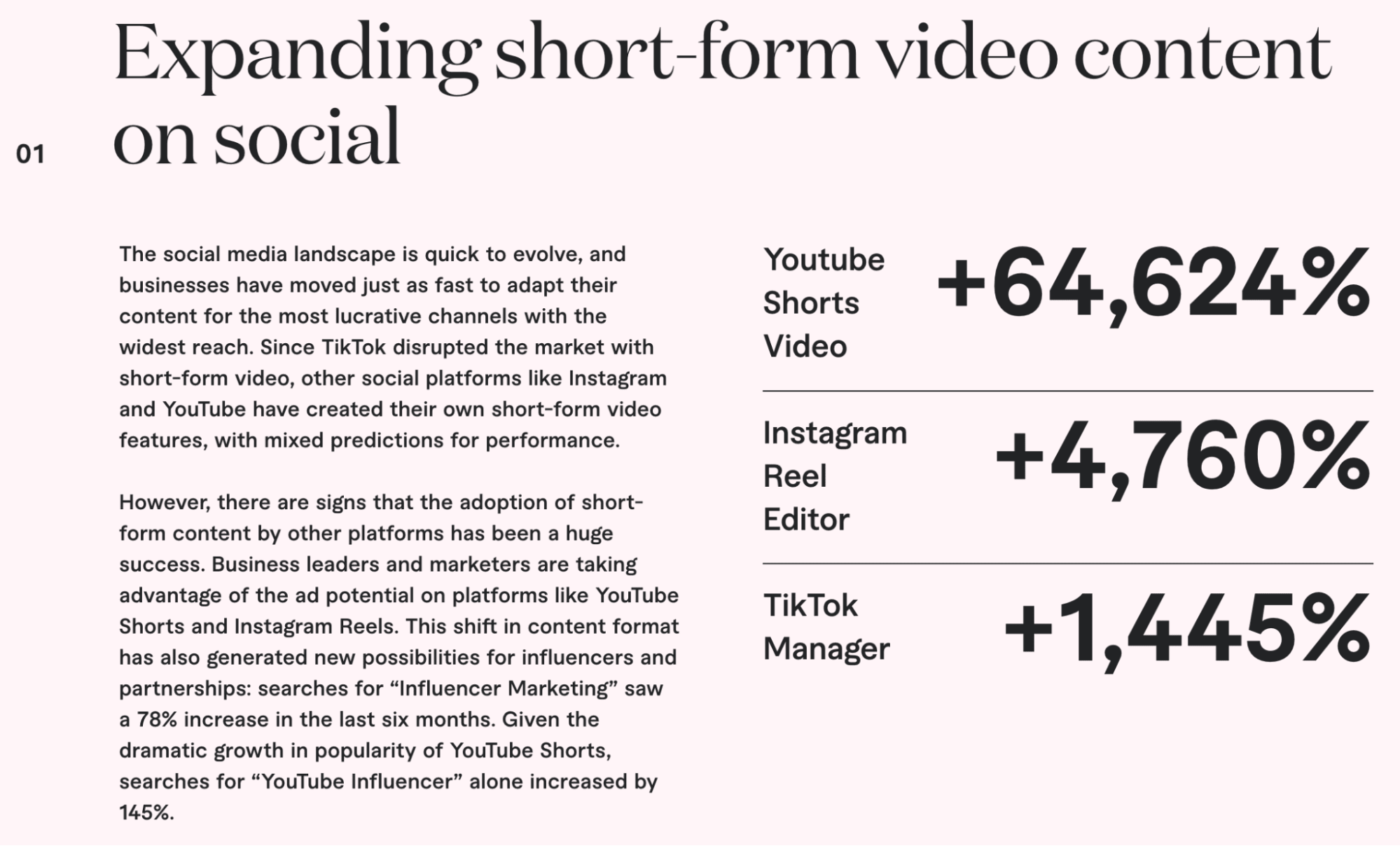
Fiverr
2. Vertical format videos
The physical appearance of videos has been moving towards a vertical portrait orientation suitable for viewing on smartphones. This departs from the horizontal landscape orientation characteristic of movie, TV, and desktop screens. Snapchat, Instagram, and TikTok have helped promote the trend toward vertical videos.
A portrait orientation emphasizes the subject’s face, which can give content marketing videos a personal touch. The ideal way to produce vertical format videos is to shoot them in the right orientation in the first place.
Pro tip: If you have a surplus of horizontal videos, see if you can edit them into a vertical orientation before you scrap them.
3. Vlogging
As the name implies, video blogging or vlogging is the video equivalent of blogging. Just as blogging is one of the most popular content forms for text-based marketing, vlogging has become a leading form of video marketing. Vlogging puts a face and a voice to your content and keeps content creators in touch with audiences on an ongoing basis.
This builds rapport and brand loyalty while making content easier to digest for those who prefer video to reading. Influencers especially have taken to vlogging, but that doesn’t mean brands shouldn’t also join in.
Some people may feel self-conscious about vlogging. In this case, consider hiring Fiverr's spokesperson video services to produce your vlog content.
Pro Tip: Try a “behind the scenes” or “day in the life” style video if you’re new to vlogging.
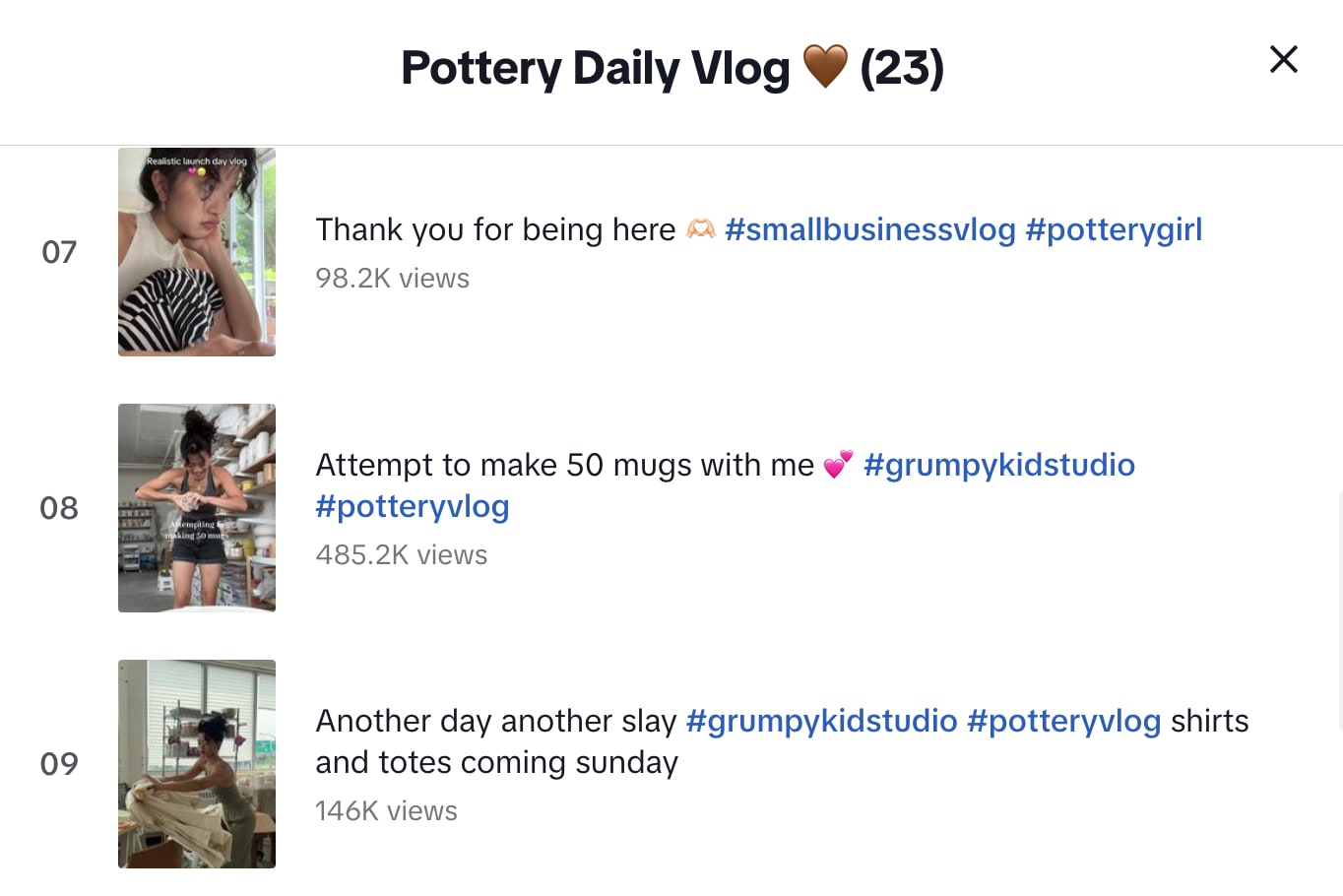
Garbo Zhu TikTok
4. Live videos
Smartphone cameras make it easy to record live videos, which has made live streaming a popular marketing tool. Live videos can be shot with little to no planning. They also allow brands to broadcast live events. This can give audiences a sense of being there with your representative in real-time.
Live streaming isn’t restricted to platforms like Twitch or the gaming space. Again, influencers are prone to live streaming “get ready with me videos.” You can adopt a similar format with your brand videos.
What if you're not sure how to shoot live video? No worries, you can easily outsource this. For example, Fiverr gives you access to filmed video production services to help you.
Pro tip: Plan your first live stream so you feel more prepared and advertise it to your audience in advance.
Find an Expert Live Video Streaming for Hire
5. Unedited video content
The growth of live videos has promoted a trend toward unedited content. This parallels the rise of reality TV and shares some of the marketing advantages of that format. Unedited content reduces the time and resources spent on editing while conveying a sense of realism that feels authentic to audiences.
Pro tip: Don’t post sloppy, unedited videos but content that feels authentic and relatable.
6. User-generated video content
Smartphones allow customers as well as businesses to generate content. This has promoted a trend toward user-generated video content. User-generated content (UGC) helps increase audience engagement by allowing customers to submit reviews and testimonials, comment on content, and participate in contests. Customers also can interact with other customers, which builds brand-centered communities and loyalty.
Pro tip: Try out influencer marketing to partner with influencers to make user-generated content.

izandco’s Instagram
Hire UGC video creators
7. Social media video ads
As videos have grown more popular on social media, advertising has shifted toward social media video ads. Social video ads let you deliver the equivalent of TV commercials to audience smartphones.
Video ads on social media are especially effective because social analytics tools allow you to segment your ads to reach specific audience demographics. Platforms display social media video ads as pop-ups when users open apps, air them between other content, or promote them as recommended content.
Need help creating a video ad suitable for social video? Digital marketing agencies can help you, or you can hire a specialist from Fiverr to design your video ads and commercials.
Pro tip: Read our guide on successful video advertising to get started and learn the basics.
8. Interactive videos
Videos can include features that allow audiences to interact with them. This has a number of important marketing applications which are gaining popularity.
One application of interactive video is encouraging audience participation. For example, audiences can click on videos to see different product features, explore variant story outcomes, or submit comments or questions.
Another important marketing application is making videos shoppable. Audiences can view products on video, and make purchases directly from videos. Your video can effectively become a buy button.
9. Augmented reality (AR) and virtual reality (VR) videos
Marketers are using augmented reality and virtual reality to promote higher audience engagement from video viewers. AR lets online shoppers view products from different angles, zoom in, or explore different model options. Combined with selfie videos, this can promote immersive online shopping experiences. For example, a customer shopping for clothes can use a selfie video to see how they’d look wearing a product in different colors.
Virtual reality takes realism a step further by letting audiences experience your brand in 3D. Online shoppers using a VR headset can browse through your digital store just as if they were walking through brick-and-mortar aisles and viewing physical products or service demonstrations.
Producing a video in AR or VR requires some knowledge of the software involved. A video specialist with skills in these areas can assist you. For example, Fiverr's marketplace features 3D product animation services to help you show and explain your product using AR.
Pro tip: Only implement AR/VR if it makes sense for your company, not just to join a trend.

Sephora
10. 4K ultra HD videos
4K or Ultra HD videos represent the latest resolution standard for new TV screens, which has made 4K content more common on digital devices. The increasing speed of Internet and smartphone connections also has helped make 4K more accessible to mobile audiences. While 4K hasn’t yet gained the popularity of previous resolution standards, marketers should expect it to become increasingly important as 4K content production increases and 5G speed network connections become more widespread.
Pro tip: Invest in a high-quality camera that can record up to 4K.
How to find help marketing with social video
Effective video marketing requires a combination of a sound marketing strategy and technical video production skills. If you lack the in-house talent to plan your video marketing strategy or produce your own videos, working with freelancers can be an efficient and cost-effective option.
Join Fiverr to access a marketplace of experienced video marketing specialists knowledgeable in audience research, video SEO, video promotion and distribution, and YouTube channel management. You can also get video and animation production services with specialties such as social media videos, video ads, and video editing.
Social video marketing FAQs
What is social media video marketing?
Social media video marketing uses videos on platforms like YouTube, TikTok, and Instagram to promote products, engage audiences, and drive sales.
How can video marketing help my business grow?
Video marketing boosts brand awareness, increases engagement, and improves conversion rates by showcasing products, telling stories, and building trust.
What types of social media videos work best?
Short-form videos, product demos, live streams, customer testimonials, and engaging ads perform well, depending on the platform and audience.

